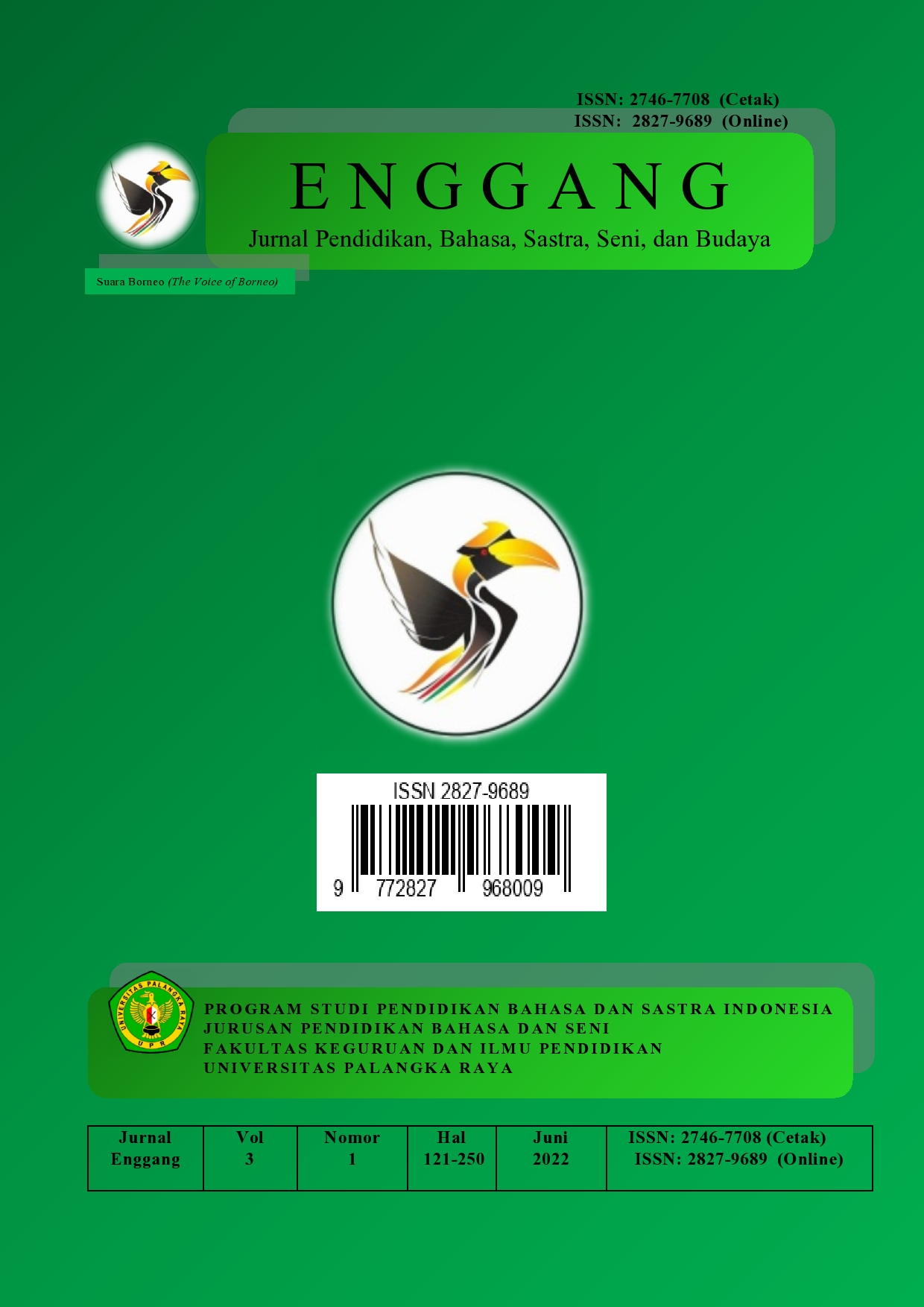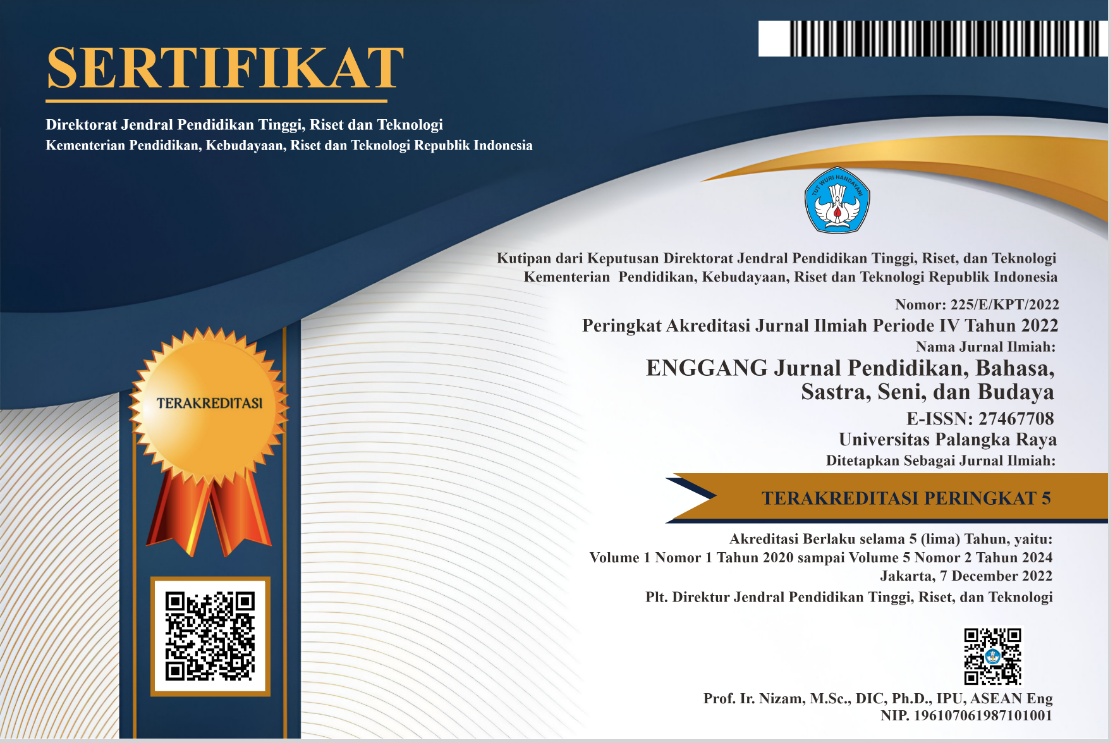Eksistensi Krumpyung Serambu: Studi Etnografi Musik Tradisional di Era Digitalisasi
DOI:
https://doi.org/10.37304/enggang.v5i1.19686Keywords:
Digitalization, Existence, Krumpyung SerambuAbstract
Krumpyung Serambu is an artisan, maker, and traditional music studio located in Tegiri Hamlet, Hargowilis Village, Kokap District, Kulon Progo Regency. In the era of digitalization, there are certainly many opinions and facts that reveal the anxiety for traditional music, including Krumpyung, to remain and develop. Ethnographic study as a method tries to reveal the existence of Krumpyung Serambu in the digitalization era. Using a realist ethnographic model, the answers in this paper refer to data from participant observation and in-depth interviews conducted with Serambu informants. Data processing and analysis are done by using Spradley's technique with the stages of domain analysis, taxonomy analysis, component analysis, and cultural theme analysis. As a result, the existence sub-domain that refers to human activities such as the recognition of Krumpyung Serambu, Krumpyung Serambu's strategy, and the relationship between history, function, and presentation form reveals that the main domain of Krumpyung Serambu and its existence still survive and strive for development, especially in the digitalization era.
Downloads
References
Amin, M. (2023). Seni pertunjukan dan industri kreatif: Menjelajah tantangan dan peluang di era global.
Aria, Z., Putra, W., Education, P. A., Training, T., & Tanjungpura, U. (2023). Revitalization analysis of forms, songs, and functions of presenting traditional music Srawung Krumpyung in Kulon Progo Regency. Grenek: Jurnal Seni Musik, 12(1), 44–52. https://doi.org/10.24114/grenek.v12i1.42065
Baert, P., Morgan, M., & Ushiyama, R. (2021). Existence theory: Outline for a theory of social behaviour. Journal of Classical Sociology, 22(1), 1–23. https://doi.org/10.1177/1468795X21998247
Bidang, A., & Lestari, W. (2021). Analisis etnografi alat musik tradisional Geso’-Geso’ dari Toraja. Visual Heritage: Jurnal Kreasi Seni Dan Budaya, 4(1), 1–6. https://doi.org/10.30998/vh.v4i1.4041
Heriyanti, N. (2018). Strategi pemasaran musik Krumpyung sebagai identitas folk musik bambu pentatonis Hargowilis Kokap Kulon Progo (pp. 1–31).
Manan, A. (2021). Metode penelitian etnografi: Untuk UIN, IAIN, STAIN, PTIS, & perguruan tinggi umum (C. I. Salasiyah, Ed.). AcehPo Publishing.
Marvasti, A. (2004). Qualitative research in sociology. SAGE Publication, Inc. https://doi.org/10.4135/9781849209700
Mutiah, D. (2021). Digitalisasi musik tradisional, antara kesempatan dan tekanan pada budaya. Liputan 6.
Ovchinnikova, Y. S. (2019). Conceptual foundations of the academic course “Traditional music in culture of peoples of the world.” Musical Art and Education, 7(1), 40–59. https://doi.org/10.31862/2309-1428-2019-7-1-40-59
Putra, Z. A. W., Olendo, Y. O., & Sagala, M. D. (2023). Kajian kritik seni: Transformasi bentuk penyajian musik tradisional Krumpyung Kulon Progo di era multimedia. Jurnal Sendratasik: Jurnal Ilmiah Pendidikan Seni Pertunjukan, 12(2), 146–156. https://doi.org/10.24036/js.v12i2.121501
Raditya, D., Arnika, P., & Kusumawardhani, M. O. A. (2022). Eksplorasi etnomatematika terhadap alat musik Demung pada kesenian Krumpyung Kulon Progo. Proseding Senatik: Seminar Nasional Matematika Dan Pendidikan Matematika, 7, 266–272. https://conference.upgris.ac.id/index.php/senatik/article/view/3317
Sari, M. P., Wijaya, A. K., Hidayatullah, B., Sirodj, R. A., & Afgani, M. W. (2023). Penggunaan metode etnografi dalam penelitian sosial. Jurnal Pendidikan Sains Dan Komputer, 3(01), 84–90. https://doi.org/10.47709/jpsk.v3i01.1956
Setyowati, S. (2014). Etnografi sebagai metode pilihan dalam penelitian kualitatif di keperawatan. Jurnal Keperawatan Indonesia, 10(1), 35–40. https://doi.org/10.7454/jki.v10i1.171
Sulistyowati, A. (2023). The existence of Sanggar Genessa in caring for Kolintang traditional music. Grenek Music Journal, 12(1), 37. https://doi.org/10.24114/grenek.v12i1.40404
Sutikno, P. Y. (2020). Era digital? “Pendidikan seni musik berbasis budaya” sebagai sebuah inovasi pembelajaran di sekolah dasar. Kreatif Jurnal Kependidikan Dasar, 11(1), 39–49. https://journal.unnes.ac.id/nju/index.php/kreatif
Vallicella, W. (2002). A paradigm theory of existence: Onto-theology vindicated. Springer Netherlands.
Waluyo, D., & Rosmawati. (2021). Dinamika seni tradisional pada era digital. Majalah Ilmiah Semi Populer Komunikasi Massa, 2(2), 161–172.
WBTI. (2017). Krumpyung Kulon Progo. Kementerian Pendidikan Dan Kebudayaan Direktorat Jenderal Kebudayaan.
Wider, K. (1995). Truth and existence: The idealism in Sartre’s theory of truth. International Journal of Philosophical Studies, 3(1), 91–109. https://doi.org/10.1080/09672559508570805
Wijaya, H. (2018). Analisis data kualitatif model Spradley (etnografi). ResearchGate, March, 1–9. https://www.researchgate.net/publication/323557072
Wilson, J. (2022). The age of digital; music executive reacts to the impact of digitalization in the music industry. Forbes.
Wimbaryadi. (2019). Musik tradisi sebagai salah satu sumber pengembangan karya cipta. Musikolastika: Jurnal Pertunjukan Dan Pendidikan Musik, 1(1), 7–12.












